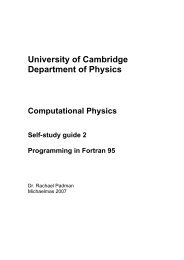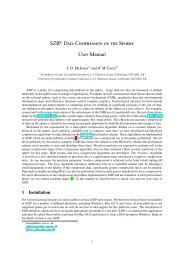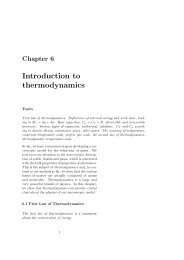- Page 1: Bayesian Methods for Astrophysics a
- Page 5: I would like to dedicate this thesi
- Page 9 and 10: Abstract This thesis is concerned w
- Page 11 and 12: Contents 1 Bayesian Inference 1 1.1
- Page 13 and 14: CONTENTS 3.3.5 Parallelization . .
- Page 15 and 16: List of Figures 1.1 Upper left: Dat
- Page 17 and 18: LIST OF FIGURES 2.9 The toy model d
- Page 19 and 20: LIST OF FIGURES 4.8 The total numbe
- Page 21: LIST OF FIGURES 6.2 The 2-dimension
- Page 24 and 25: 1.1 Bayesian Modelling Two fundamen
- Page 26 and 27: |∆ log E| Odds Probability Remark
- Page 28 and 29: 1.5 Comparing Data-Sets This joint
- Page 30 and 31: c 1.6 1.4 1.2 1 0.8 0.6 (a) 0.4 0.6
- Page 32 and 33: c 2 1.5 1 (a) 0.5 −1 0 1 2 m (c)
- Page 34 and 35: of the (i + 1) th point is given as
- Page 36 and 37: 1.6 Numerical Methods posterior dis
- Page 38 and 39: log L 1 Anneal log X (a) 0 F E D 1.
- Page 40 and 41: 2.2 Introduction modes and signific
- Page 44 and 45: 2.3 Nested Sampling Nested sampling
- Page 46 and 47: (a) (b) (c) (d) (e) 2.3 Nested Samp
- Page 48 and 49: 2.4 Ellipsoidal Nested Sampling H/
- Page 50 and 51: 2.5 Improved Ellipsoidal Sampling M
- Page 52 and 53: 2.5 Improved Ellipsoidal Sampling M
- Page 54 and 55: 2.5 Improved Ellipsoidal Sampling M
- Page 56 and 57: 2.5 Improved Ellipsoidal Sampling M
- Page 58 and 59: 2.5 Improved Ellipsoidal Sampling M
- Page 60 and 61: 2.6 Metropolis Nested Sampling volu
- Page 62 and 63: 2.7 Applications iteration since th
- Page 64 and 65: 2.7 Applications Figure 2.6: As in
- Page 66 and 67: Peak X Y Local log Z 1 −0.400 ±
- Page 68 and 69: L 5 4 3 2 1 0 -5 -2.5 0 x 2.5 5 -5
- Page 70 and 71: 48 Analytical Method 2 (with sub-cl
- Page 72 and 73: 2.8 Bayesian Object Detection Metho
- Page 74 and 75: Object X Y A R 1 43.71 22.91 10.54
- Page 76 and 77: Log-Likelihood (L) -84800 -84900 10
- Page 78 and 79: 2.8 Bayesian Object Detection Metho
- Page 80 and 81: 2.9 Discussion and Conclusions lar
- Page 82 and 83: 2.9 Discussion and Conclusions elli
- Page 84 and 85: 3.2 Introduction 3.2 Introduction I
- Page 86 and 87: 3.3 The MultiNest Algorithm The phy
- Page 88 and 89: where γ is a constant, 3.3 The Mul
- Page 90 and 91: (a) (b) 3.3 The MultiNest Algorithm
- Page 92 and 93:
3.3 The MultiNest Algorithm greater
- Page 94 and 95:
3.3.6 Identification of Modes 3.3 T
- Page 96 and 97:
1 u 2 G 5 G 6 G 3 G 7 3.3 The Multi
- Page 98 and 99:
3.3 The MultiNest Algorithm For eac
- Page 100 and 101:
250 200 150 100 50 0 0 250 200 150
- Page 102 and 103:
Mode true local log(Z) MultiNest lo
- Page 104 and 105:
3.5 Cosmological Model Selection fr
- Page 106 and 107:
0.018 ≤ Ωbh 2 ≤ 0.032 0.04
- Page 108 and 109:
3.6 Comparison of MultiNest and MCM
- Page 110 and 111:
3.7 Discussion and Conclusions dete
- Page 112 and 113:
3.7 Discussion and Conclusions As a
- Page 114 and 115:
3.7 Discussion and Conclusions For
- Page 116 and 117:
4.2 Introduction The number count o
- Page 118 and 119:
4.3 Methodology The unlensed ellipt
- Page 120 and 121:
4.3.3 Quantifying Cluster Detection
- Page 122 and 123:
4.3 Methodology Figure 4.1: Samples
- Page 124 and 125:
4.4 Application to Mock Data: Recov
- Page 126 and 127:
False Positives 20 18 16 14 12 10 8
- Page 128 and 129:
c log R 16 14 12 10 8 6 4 2 0 0 0.5
- Page 130 and 131:
4.5.1 Mock Shear Survey Data 4.5 Ap
- Page 132 and 133:
No. of Clusters 1000 100 10 1 0 0.2
- Page 134 and 135:
1 0.8 0.6 0.4 0.2 0 0 0.2 0.4 0.6 0
- Page 136 and 137:
∆x/arcsec ∆z ∆x/arcsec ∆z 4
- Page 138 and 139:
4.6 Conclusions the true parameters
- Page 140 and 141:
Chapter 5 Bayesian Analysis of Mult
- Page 142 and 143:
5.2 Introduction intensive Markov C
- Page 144 and 145:
5.4 Cluster Modelling through the S
- Page 146 and 147:
5.4 Cluster Modelling through the S
- Page 148 and 149:
5.4.2 SZ Data 5.4 Cluster Modelling
- Page 150 and 151:
5.4 Cluster Modelling through the S
- Page 152 and 153:
p(α) 1 0.8 0.6 0.4 0.2 0 5.4 Clust
- Page 154 and 155:
5.4 Cluster Modelling through the S
- Page 156 and 157:
5.5 Application to Simulated SZ Obs
- Page 158 and 159:
5.5 Application to Simulated SZ Obs
- Page 160 and 161:
T/keV 20 18 16 14 12 10 8 6 4 2 M /
- Page 162 and 163:
5.6 Application to MACS 0647+70 Par
- Page 164 and 165:
y 0 /arcsec r core /h −1 kpc β M
- Page 166 and 167:
Chapter 6 Bayesian Selection of sig
- Page 168 and 169:
6.2 Introduction performing a multi
- Page 170 and 171:
mSUGRA parameters 2 TeV range 4 TeV
- Page 172 and 173:
6.3 The Analysis Observable Mean va
- Page 174 and 175:
6.3 The Analysis The W boson pole m
- Page 176 and 177:
6.3 The Analysis The SM prediction
- Page 178 and 179:
6.4 Results 6.4 Results In this sec
- Page 180 and 181:
m0 (TeV) 4 3.5 3 2.5 2 1.5 1 0.5 0.
- Page 182 and 183:
m0 (TeV) 4 3.5 3 2.5 2 1.5 1 0.5 0.
- Page 184 and 185:
P/Pmax P/Pmax 1 0.75 0.5 0.25 0 1 0
- Page 186 and 187:
6.4 Results as shown previously by
- Page 188 and 189:
m0 (TeV) m0 (TeV) m0 (TeV) m0 (TeV)
- Page 190 and 191:
6.5 Summary and Conclusions predict
- Page 192 and 193:
7.1 Analysis Methods provides a ver
- Page 194 and 195:
REFERENCES Allanach, B.C., Cranmer,
- Page 196 and 197:
REFERENCES Beltrán, M., García-Be
- Page 198 and 199:
REFERENCES Condon, J.J. (1974). Con
- Page 200 and 201:
REFERENCES Ellis, J., Heinemeyer, S
- Page 202 and 203:
REFERENCES Guth, A.H. (1981). Infla
- Page 204 and 205:
REFERENCES Jenkins, A., Frenk, C.S.
- Page 206 and 207:
REFERENCES Li, C.T. et al. (2006).
- Page 208 and 209:
REFERENCES Misiak, M. & Steinhauser
- Page 210 and 211:
REFERENCES for Astronomy II. Edited
- Page 212 and 213:
REFERENCES Stark, L.S., Hafliger, P
- Page 214 and 215:
REFERENCES Waldram, E.M., Bolton, R






